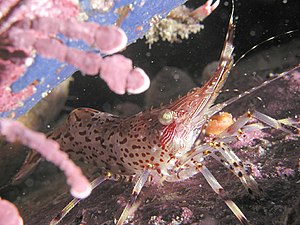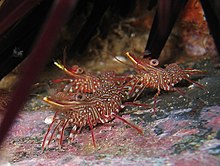Caridea
| Caridea | ||||||||||||
|---|---|---|---|---|---|---|---|---|---|---|---|---|

Caridea |
||||||||||||
| Systematics | ||||||||||||
|
||||||||||||
| Scientific name | ||||||||||||
| Caridea | ||||||||||||
| Dana , 1852 |
Among the Caridea include more than 2,500 of the 3,000 shrimp designated crustaceans . They are mostly small crustaceans with a cylindrical carapace . Most Caridea species live in the sea, including in coral reefs and in the deep sea , but there are also freshwater species (e.g. freshwater shrimp (Atyidae)).
features
The first two pairs of legs are with or without scissors. The third pair of legs is always without scissors. The second segment of the abdomen is laterally widened and protrudes over the rear edge of the first and the front edge of the third abdominal segment . The gills consist of a central shaft with round branches. As in all pleocyemata, the females carry the eggs with them on their abdomen until the protozoal larvae hatch .
Systematics

Superfamilies and families:
-
Alpheoidea Rafinesque, 1815
- Snapper or pistol shrimp (Alpheidae) Rafinesque, 1815
- Barbouriidae Christoffersen, 1987
- Cleaner and marble shrimp (Hippolytidae) Dana, 1852
- Ogyrididae Holthuis, 1955
- Atyoidea de Haan, 1849
- Freshwater shrimp (Atyidae) de Haan, 1849
-
Bresilioidea Calman, 1896
- Agostocarididae Hart & Manning, 1986
- Alvinocarididae Christoffersen, 1986
- Bresiliidae Calman, 1896
- Disciadidae Rathbun, 1902
- Pseudochelidae De Grave & Moosa, 2004
-
Campylonotoidea Sollaud, 1913
- Bathypalaemonellidae de Saint Laurent, 1985
- Campylonotidae Sollaud, 1913
-
Crangonoidea Haworth, 1825
- Crangonidae Haworth, 1825
- Glyphocrangonidae Smith, 1884
- Galatheacaridoidea Vereshchaka, 1997
- Galatheacarididae Vereshchaka, 1997
-
Nematocarcinoidea Smith, 1884
- Eugonatonotidae Chace, 1937
- Nematocarcinidae Smith, 1884
- Dancing shrimp (Rhynchocinetidae) Ortmann, 1890
- Xiphocarididae Ortmann, 1895
- Oplophoroidea Dana, 1852
- Oplophoridae Dana, 1852
-
Palaemonoidea Rafinesque, 1815
- Anchistioididae Borradaile, 1915
- Desmocarididae Borradaile, 1915
- Euryrhynchidae Holthuis, 1950
- Bumblebee Shrimp (Gnathophyllidae) Dana, 1852
- Harlequin shrimp (Hymenoceridae) Ortmann, 1890
- Kakaducarididae Bruce, 1993
- Rock and partner shrimp (Palaemonidae) Rafinesque, 1815
- Typhlocarididae Annandale & Kemp, 1913
-
Pandaloidea Haworth, 1825
- Deep-sea shrimp (Pandalidae) Haworth, 1825
- Thalassocaridae Bate, 1888
- Pasiphaeoidea Dana, 1852
- Glass shrimp (Pasiphaeidae) Dana, 1852
- Physetocaridoidea Chace, 1940
- Physetocarididae Chace, 1940
- Procaridoidea Chace & Manning, 1972
- Procariddae Chace & Manning, 1972
- Processoidea Ortmann, 1890
- Processidae Ortmann, 1890
- Psalidopodoidea Wood Mason & Alcock, 1892
- Psalidopodidae Wood Mason & Alcock, 1892
- Stylodactyloidea Bate, 1888
- Stylodactylidae Bate, 1888
use
fishing
A few Caridea species are caught commercially (e.g. the North Sea shrimp ( Crangon crangon )) or propagated in shrimp farms (e.g. Macrobrachium rosenbergii , Fam. Palaemonidae) and are sought-after delicacies . Most of the edible "shrimp" belong to the Penaeoidea and not to the Caridea.
Aquarium keeping
Some freshwater shrimp and rock shrimp are also kept in freshwater aquariums, e.g. B. the Japanese freshwater shrimp , which is popular as an algae fighter. Crabs , cleaner and marble shrimp , rock and partner shrimp , harlequin shrimp and dance shrimp are kept in seawater aquariums . The claw shrimp, which are also kept in saltwater aquariums, do not belong to the Caridea.
swell
- Helmut Debelius : Cancer Guide . Jahr Verlag, 2000, ISBN 3-86132-504-7
- Svein A. Fosså / Alf Jacob Nilsen: Coral reef aquarium. Volume 6, Birgit Schmettkamp Verlag, Bornheim 1998, ISBN 3-928819-18-6
Individual evidence
- ↑ Sammy De Grave, N. Dean Pentcheff, Shane T. Ahyong et al .: A classification of living and fossil genera of decapod crustaceans . In: Raffles Bulletin of Zoology . Supplement No. 21. 2009, p. 1–109 ( pdf 7.73Mb [accessed March 11, 2012]).



